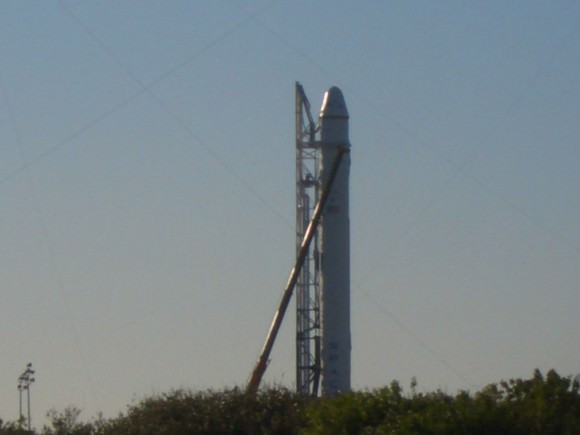A couple of holiday themed videos for you from NASA, and look back at 2010. The ISS crew has the strangest looking Christmas tree ever, as seen below.
Continue reading “Seasons Greetings and a Look Back at 2010 from NASA”
A couple of holiday themed videos for you from NASA, and look back at 2010. The ISS crew has the strangest looking Christmas tree ever, as seen below.
Continue reading “Seasons Greetings and a Look Back at 2010 from NASA”
[/caption]
A temporary spending measure signed by President Obama on December 22 means NASA and other government agencies will stay at 2010 funding levels until March 4, 2011. This means, according to Jeff Foust at Space Politics, that among other items, the prohibition in the FY10 appropriations bill that prevents NASA from terminating any Constellation programs remains in effect, despite the human spaceflight plan enacted in the NASA authorization act signed into law in October.
The temporary measure, H.R. 3082, known as a continuing resolution, was passed by the House of Representatives on Dec. 21. With its signing by the president, NASA will continue to operate at spending rates proportional to the $18.72 billion appropriated for all of 2010, according to Space News.
An earlier version of the bill would have funded the federal government for the remainder of fiscal year 2011 and would have increased NASA spending by $186 million over 2010 levels and provided authority to cancel Constellation contracts and initiate new programs in the current fiscal year, but the measure stalled in the Senate under Republican opposition to earmarks contained in the $1.1 trillion funding package.
The continuing resolution, however, doesn’t not specify what money at NASA should be used for specific items, and so the additional shuttle flight that was deemed a certainty in the NASA Authorization Act of 2010 that Obama signed into law Oct. 11, will likely still happen, but it’s not a sure thing.
NASA spokesman Michael Cabbage said the agency was still reviewing H.R. 3082, but “The continuing resolution by itself does not endanger the extra shuttle mission, because on an annualized basis the continuing resolution provides enough funding to fly the mission,” Cabbage was quoted in Space News.
However, Foust suggested that “there remains the possibility that a new, more fiscally conservative Congress might seek to cut funding below the 2010 levels, either overall or for specific programs, when it convenes in January.”
So while NASA can’t cancel its Constellation contracts, the lack of specificity for NASA programs in H.R. 3082 gives the agency authority to continue developing a the Orion crew vehicle for deep space missions as called for in the authorization act. And because Congress provided $100 million for development of a heavy-lift rocket in the 2010 appropriation, NASA could begin work on that or a similar vehicle as directed in the authorization measure – all the while still paying for Constellation.
And the continuing resolution could pose potential problems for NASA’s Commercial Orbital Transportation Services (COTS) program, said Space News.
Under Obama’s 2011 budget proposal, NASA would have received $500 million for the effort to help commercial companies develop rockets and cargo ships capable of resupplying the space station. But because the program is new, and was not funded in the 2010 appropriation, NASA could be left to await new appropriations legislation before it can get started.
Many other NASA programs face uncertainty in their budgets, as well.
Sources: Space News, Space Politics
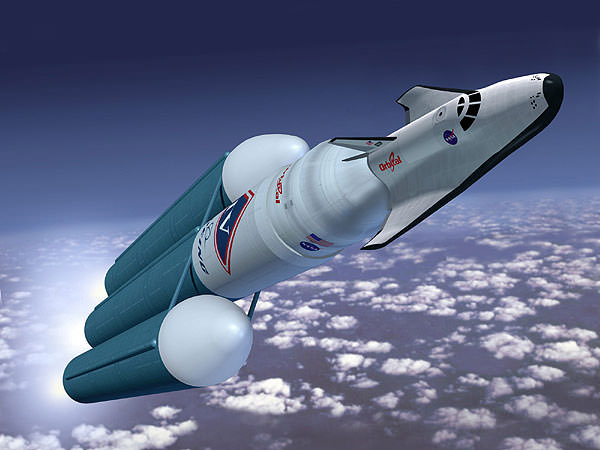
[/caption]
Once, the field had only had few entries, but now there are several companies vying to send American astronauts into orbit. With NASA’s Commercial Crew Development program, or CCDev 2, and the encouragement of commercial space firms to produce their own vehicles, the number of potential ‘space-taxis’ has swelled, with virtually every established and up-and-coming aerospace company either producing – or proposing one.
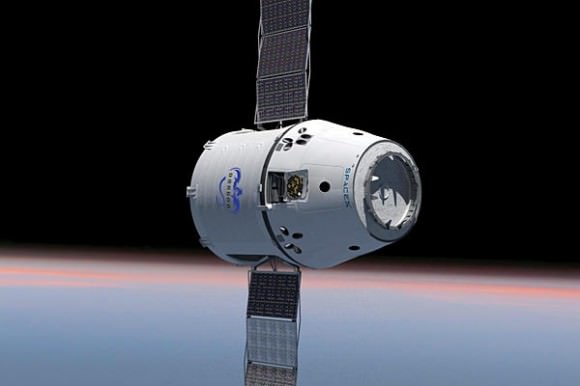
One of the first firms to unveil a potential means of transportation to the International Space Station (ISS) was Space Exploration Technologies (SpaceX). SpaceX launched the first of its Dragon spacecraft on Dec. 8, and shortly thereafter became the first private company to safely recover a spacecraft after it returned from orbit.
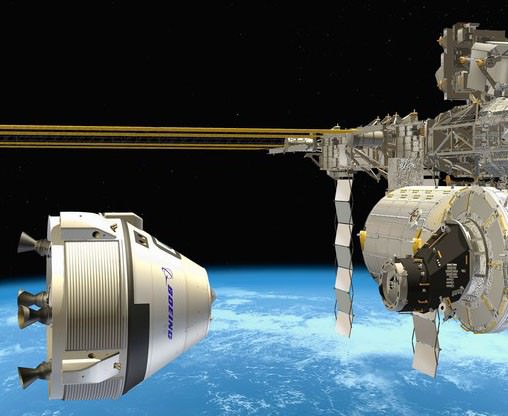
Not to be out done by the ‘new kid on the block’ Boeing unveiled its version of a space taxi this past September. Boeing’s Crew Space Transportation-100 (CST-100) spacecraft which it described could be used for missions to the space station or other ‘LEO platforms.’ One potentially exciting prospect about this endeavor is that any excess seating capacity will be available for purchase through Space Adventures.
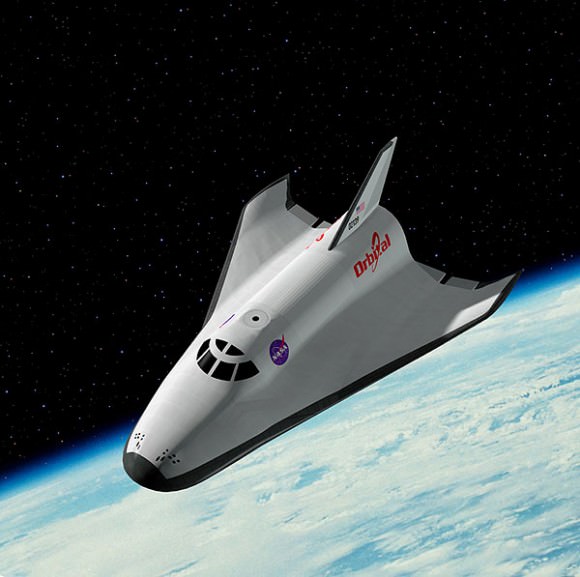
A step away from what most of these companies are doing, Orbital Sciences has proposed producing a ‘mini-shuttle’ to ferry passengers to and from orbit. Most aerospace companies that have submitted designs and ideas have stepped away from the space plane concept as it is now viewed as too complicated and expensive. However, the U.S. Air Force recently successfully demonstrated the viability of its unmanned X-37B space plane. It was perhaps with this in mind that emboldened Orbital to go a step further and produce a man-rated mini space plane. Orbital images show their spacecraft proposal being lifted to orbit atop a Delta IV Heavy.
Just this month Virgin Galactic also announced its plans to produce a space plane (the company uses a space plane in its sub-orbital commercial efforts – this new space plane appears to be an extension of that).

Lastly Sierra Nevada Corp also has thrown its name into the ring proposing a winged spacecraft. Their ‘Dream Chaser’ spacecraft is similar to Orbital’s proposal, a winged spacecraft that would be launched to orbit atop an expendable launch vehicle.
These companies are all vying for the $200 million that NASA has placed into a program to promote ease of access to orbit. While the Orion spacecraft, produced by Lockheed Martin, is part of a NASA program – these other organizations are hoping that by demonstrating the viability of their technology – that they can also secure a strong position in the emerging commercial space market.
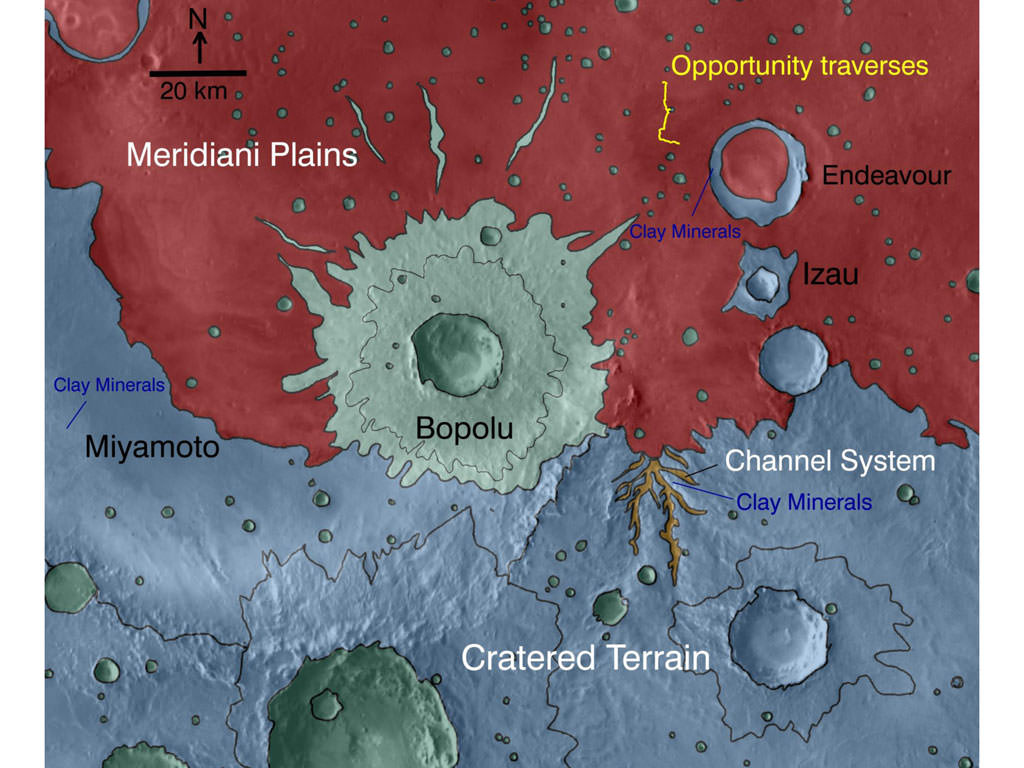
[/caption]
NASA is using its powerful science surveyor orbiting more than 241 kilometers above Mars to target the surface explorations of the long lived Opportunity rover to compelling science targets on the ground. Opportunity is currently on a long term trek to the giant crater named Endeavour, some 22 kilometers in diameter, which shows significant signatures of clays and water bearing sulfate minerals which formed in the presence of flowing liquid water billions of years ago.
An armada of orbiters and rovers from Earth are carrying out a coordinated attack plan to unlock the mysteries of the red planet, foremost being to determine whether life ever arose on Mars.
On Dec. 15 (Sol 2450), Opportunity arrived at Santa Maria crater which is just 6 km distant from the western rim of Endeavour. Over the past 2 years, the rover has traversed more than two thirds of the 19 km distance from Victoria crater -her last big target – to Endeavour.
High resolution spectral and imaging mappers aboard NASA’s Mars Reconnaissance Orbiter (MRO) are enabling researchers on the rover team to prioritize targets and strategically guide Opportunity to the most fruitful locations for scientific investigations.
The on board CRISM mapping spectrometer has detected clay minerals, or phyllosilicates, at multiple locations around Endeavour crater including the western rim closest to Opportunity. CRISM is the acronym for Compact Reconnaissance Imaging Spectrometer for Mars. Images from MRO’s HiRISE camera are utilized to scout out the safest and most efficient route. See maps above and below.
“This is the first time mineral detections from orbit are being used in tactical decisions about where to drive on Mars,” said Ray Arvidson of Washington University in St. Louis. Arvidson is the deputy principal investigator for the Spirit and Opportunity rovers and a co-investigator for CRISM.
Clay minerals are a very exciting scientific find because they can form in more neutral and much less acidic aqueous environments which are more conducive to the possibility for the formation of life. They have never before been studied up close by science instruments on a landed mission.
Opportunity may soon get a quick taste of water bearing sulfate minerals at Santa Maria because spectral data from CRISM suggest the presence of sulfate deposits at the southeast rim of the crater. Opportunity has previously investigated these sulfate minerals at other locations along her circuitous traverse route – but which she discovered without the help of orbital assets.
“We’ve just pulled up to the rim of Santa Maria, and the workload is very high,” Steve Squyres informed me. Squyres, of Cornell University, is the Principal Scientific Investigator for NASA’s Spirit and Opportunity Mars rovers.
Opportunity drove to within about 5 meters of the crater rim on Dec. 16 (Sol 2451). JPL Mars rover driver Scott Maxwell tweeted this message ; “Today’s NAVCAM mosaic of Santa Maria Crater. Woo-hoo! Glorious and beautiful!” and this twitpic
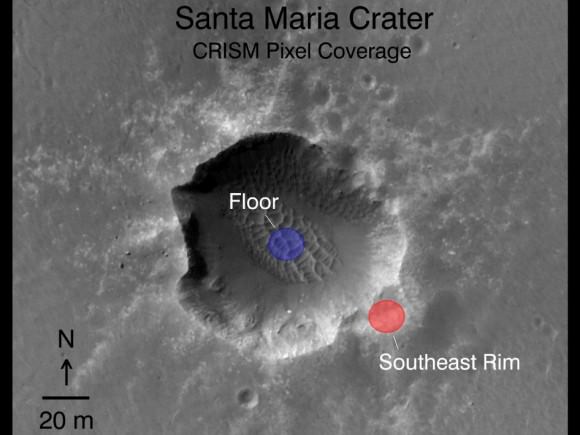
The rover will conduct an extensive science campaign at Santa Maria by driving to different spots over the next several weeks and gathering data to compare observations on the ground to those from CRISM in orbit.
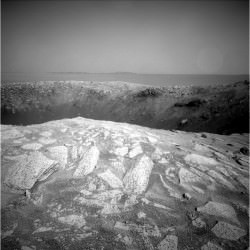
Santa Maria crater appears to be relatively fresh and steep walled and was likely created by a meteor strike only a few million years ago. Endeavour is an ancient crater with a discontinuous rim that is heavily eroded at many points. By exploring craters, scientists can look back in time and decipher earlier geologic periods in Mars history.
Scientists believe that the clay minerals stem from an earlier time period in Martian history and that the sulfate deposits formed later. Mars has experiences many episodes of wet environments at diverse locations in the past and climate-change cycles persist into the present era.
After the upcoming Solar Conjunction in February 2011, Opportunity will depart eastwards for the last leg of the long march to Endeavour. She heads for a rim fragment dubbed Cape York which spectral data show is surrounded by exposures of water bearing minerals. Cape York is not yet visible in the long distance images because it lies to low. See maps below.
Thereafter, Opportunity alters direction and turns south towards her next goal –
Cape Tribulation – which is even more enticing to researchers because CRISM has detected exposures of the clay minerals formed in the milder environments more favorable to life. Cape Tribulation has been clearly visible in rover images already taken months ago in early 2010.
Opportunity could reach Endeavour sometime in 2011 if she can continue to survive the harsh environment of Mars and drive at her current accelerated pace. Opportunity arrived at Mars in January 2004 for a planned 90 day mission. The rover has far surpassed all expectations and will soon celebrate 7 earth years of continuous operations on the red planet. Virtually all the data from Spirit and Opportunity are relayed back to Earth via NASA’s Mars Odyssey orbiter.
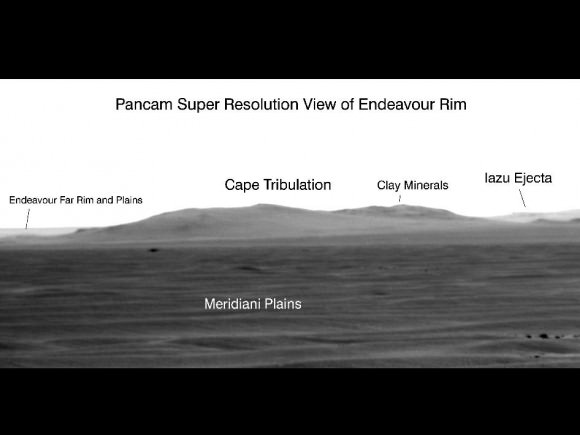
Opportunity used its panoramic camera in a super-resolution technique to record this view of the horizon on Sol 2298 (July 11, 2010) which shows the western rim of Endeavour Crater, including the highest ridge informally named “Cape Tribulation”. CRISM data revealed exposures of clay minerals at Cape Tribulation.
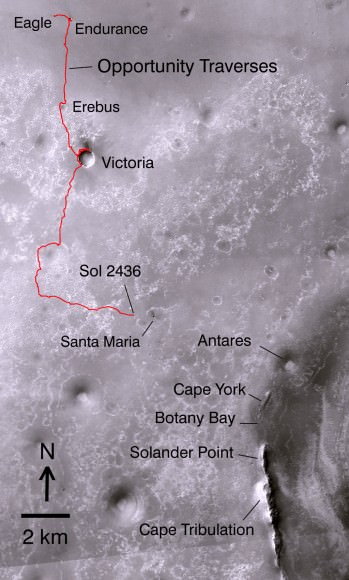
Opportunity’s Path on Mars Through Sol 2436
The red line shows where Opportunity has driven from the place where it landed in January 2004 — inside Eagle Crater, at the upper left end of the track — to where it reached on the 2,436th Martian day, or sol, of its work on Mars (Nov. 30, 2010). The map covers an area about 15 kilometers (9 miles) wide. North is at the top. Subsequent drives brought Opportunity to Santa Maria Crater, which is about 90 meters (295 feet) in diameter. After investigating Santa Maria the rover heads for Endeavour Crater. The western edge of 22-kilometer-wide (14-mile-wide) Endeavour is in the lower right corner of this map. Some sections of the discontinuous raised rim and nearby features are indicated with informal names on the map: rim segments “Cape York” and “Solander Point”; a low area between them called “Botany Bay”; “Antares” crater, which formed on sedimentary rocks where the rim was eroded down; and rim fragment “Cape Tribulation,” where orbital observations have detected clay minerals. The base map is a mosaic of images from the Context Camera on NASA’s Mars Reconnaissance Orbiter.
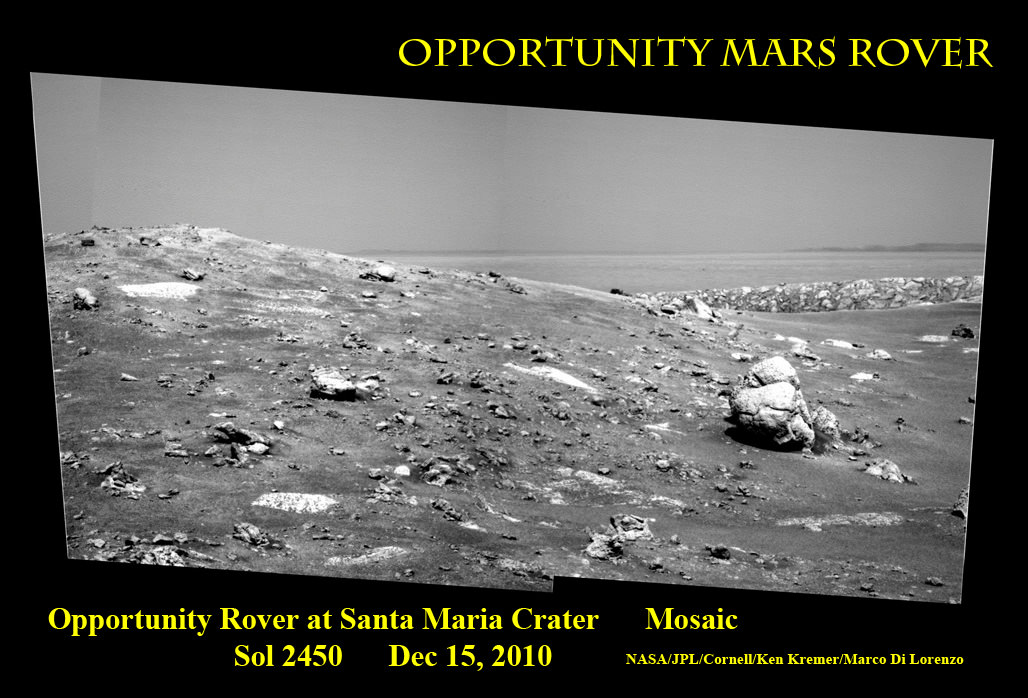
[/caption]
NASA’s Opportunity Mars rover arrived today (Dec .15) at Santa Maria crater on Sol 2450. She sits just 20 meters from the crater rim. A multitude of inviting rocks and boulders are strewn about the 80 meter diameter crater, making this a Martian geologists dream.
And so it goes too for a Martian photographer with lots to shoot and with the giant 14 km wide Endeavour crater serving as backdrop and coming into ever clearer focus.
Santa Maria is just 6 km from the western rim of Endeavour (see panoramic mosaics above and below).
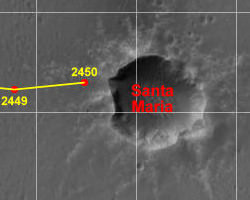
Opportunity has been on a swift advance since departing from Intrepid crater in mid-November and driven about 1.5 km over very smooth terrain. The rover continues to benefit from a bounty of solar power and upgraded software enabling longer and more frequent days of drives. Opportunity has now driven a total of 26.4 km.
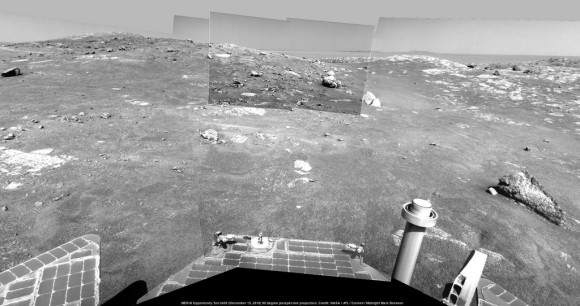
The rover team is planning for an extensive and multi week science campaign at Santa Maria using all the instruments and cameras at their disposal.
Opportunity will spend the holiday season and the upcoming Solar conjunction exploring around Santa Maria according to Matt Golembek, Mars Exploration Program Landing Site Scientist at the Jet Propulsion Laboratory (JPL), Pasadena, Calif.
There will be no uplink commanding to the spacecraft around the actual conjunction period from Jan. 28 to Feb. 12 (UTC) out of caution that the command transmission could be disrupted.
The team plans a sophisticated wide-baseline stereo-imaging survey of Santa Maria by having Opportunity drive to several positions halfway around the crater. A mineral survey will be carried out using the spectrometers, microscope and drill – known as the RAT or rock abrasion tool – located at the terminus of the rover’s robotic arm.
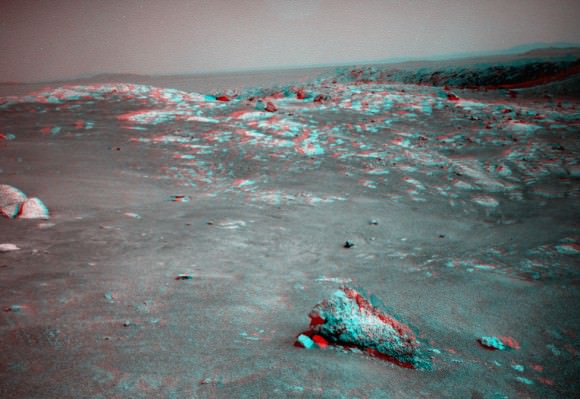
See several additional amateur mosaics below – including 3 D images – from all of us at unmannedspaceflight .com.
The rover is now at the two thirds mark of a 19 km (12 mile) journey from Victoria crater on the road to reach the rim of the scientifically rich environs of Endeavour crater sometime later in 2011. Opportunity explored the rim and interior of Victoria from mid-2006 to mid-2008.
Santa Maria is the largest feature that Opportunity will explore between Victoria and Endeavour craters. The team assigns informal names to craters visited by Opportunity based on the names of historic ships of exploration in human history. See Opportunity traverse maps below.
More than 95 percent of the data from Spirit and Opportunity are relayed by NASA’s Mars Odyssey orbiter. Today, Odyssey broke the record for being the longest-serving spacecraft at the Red Planet during it’s 3,340th day in Martian orbit.
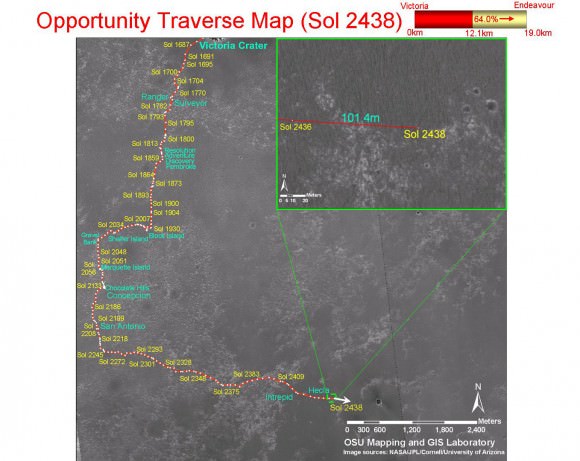
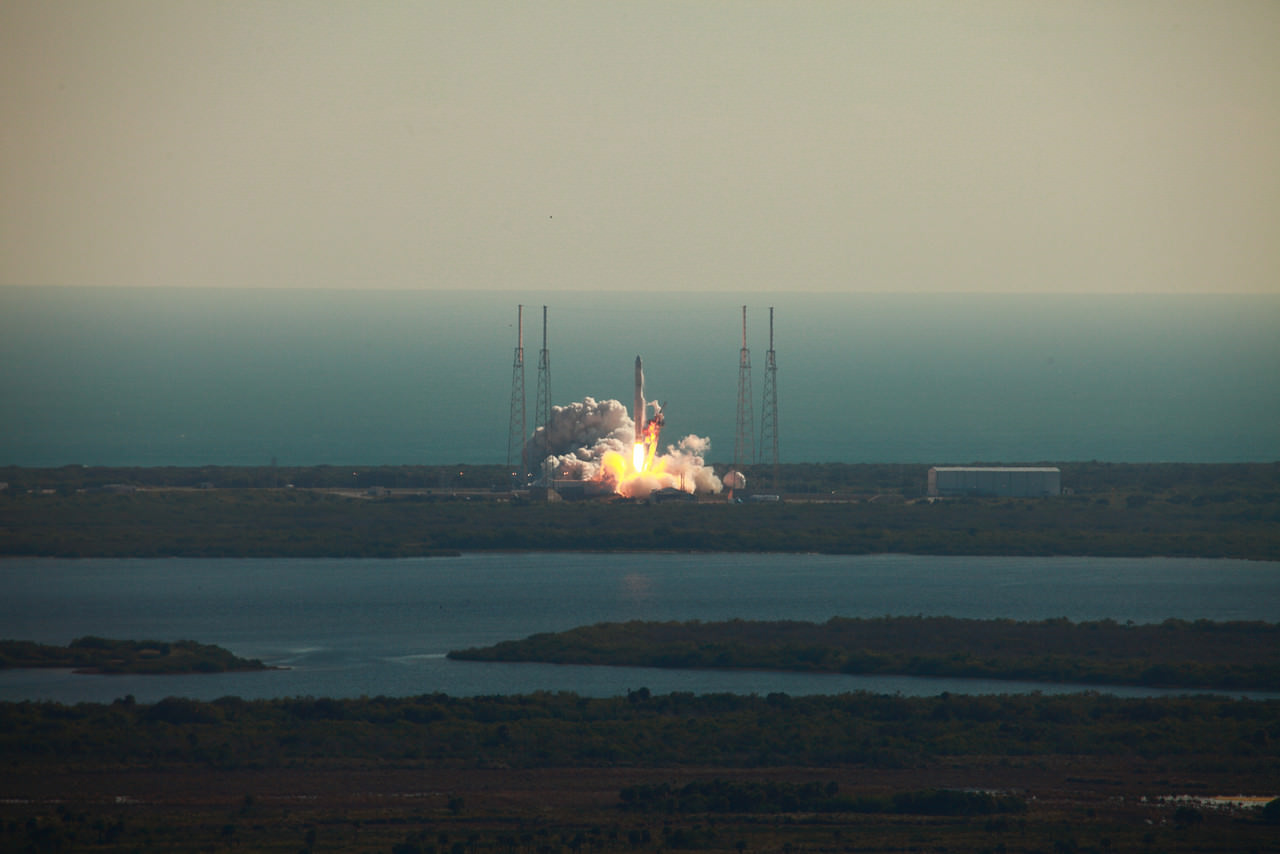
[/caption]
With the success of the first and second launches of the Falcon 9 rocket as well as the successful recovery of the Dragon spacecraft, Space Exploration Technologies (SpaceX) has stated its intent to accelerate the pace of the Commercial Orbital Transportation Services (COTS) program that the private space firm has with NASA. The company has been inspecting various elements of the Dragon spacecraft that launched to orbit on Dec. 8, to make potential changes to the next Dragon – in preparation for its flight.
The company became the first private organization in history to launch a vehicle into orbit and then have it successfully return safely to Earth. The company has, for some time, been working to step up the pace of the COTS program. Under this program the first three flights of the Dragon would be demonstration flights with the third, and final demonstration flight docking with the International Space Station (ISS).
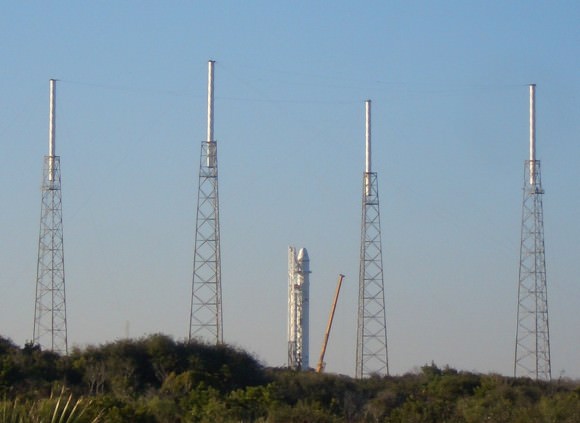
SpaceX is, if anything, a young and restless company, a company on the move and as such they want to combine the mission requirements of the second and third flights – into one. In short, SpaceX is hoping to send their next Dragon – to the space station itself, cutting out one demonstration flight in the process. However, while officials at SpaceX and the company’s CEO and CTO Elon Musk are attempting to relive the golden age of manned spaceflight (this effort is somewhat similar to the accelerated launch of the Apollo 8 mission) – NASA appears uncertain about speeding up the process. NASA has stated that if all went well with the first flight of the Dragon that it would consider speeding up the program.
The next flight of the Dragon spacecraft could take place as soon as the middle of next year. According to Musk, there are few differences between the maneuvers that Dragon conducted on Orbit this past Wednesday – and those that would be required if the craft were to rendezvous with the ISS. For a mission to the orbiting outpost, the Dragon would need to be equipped with solar arrays and certain equipment on board the craft would need to be upgraded.
To date, NASA has only stated that it is assessing the possibility of accelerating the program and that it recognizes the successes that SpaceX has enjoyed. Those within the space community note that NASA has a risk-averse philosophy and that the agency will likely want to see the company complete the requirements of the initial contract and fully demonstrate the Dragon’s capabilities.
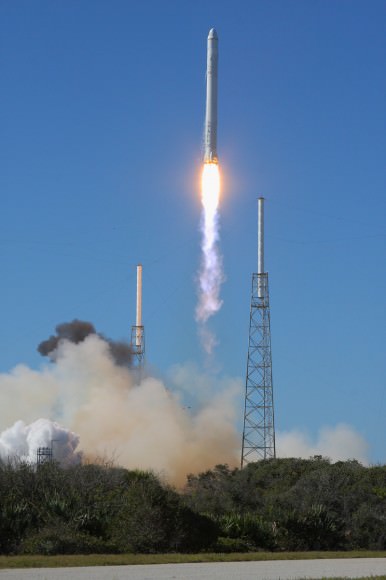
[/caption]
We reported the successful ejection of the Nanosail-D nanosatellite from the satellite that it was launched with earlier this week. Well, the most recent release from NASA states that things might have turned out otherwise. Not only has the sail potentially failed to deploy, it’s currently unclear if the nanosatellite was even ejected.
In NASA’s own words on the mission site:
At this time, it is not clear that NanoSail-D ejected from the Fast, Affordable, Science and Technology Satellite (FASTSAT) as originally stated on Monday, Dec. 6. At the time of ejection, spacecraft telemetry data showed a positive ejection as reflected by confirmation of several of the planned on orbit ejection sequence events. The FASTSAT spacecraft ejection system data was also indicative of an ejection event. NanoSail-D was scheduled to unfurl on Dec. 9 at 12:30 a.m., and deployment hasn’t been confirmed. The FASTSAT team is continuing to trouble shoot the inability to make contact with NanoSail-D. The FASTSAT microsatellite and all remaining five onboard experiments continue to operate as planned.
What a bummer. This is all we have to go on right now – we’ll keep you posted as the situation develops over the weekend.
Source: NASA press release
There are a lot of solar system space missions coming up, plus – as always – a plethora of astronomical events taking place, so NASA has decided to declare the “Year of the Solar System” (YSS). But this year is so big, it won’t fit into an Earth year — however, a Martian year just about covers it, so from now until August, 2012 we’re celebrating.
“During YSS, we’ll see triple the usual number of launches, flybys and orbital insertions,” said Jim Green, the director of Planetary Science at NASA headquarters. “There hasn’t been anything quite like it in the history of the Space Age. History will remember the period Oct. 2010 through Aug. 2012 as a golden age of planetary exploration.”
Below you’ll see a list of mission activities that will take place, but also, the YSS organizers will have special events – both online and at various venues – to help us all celebrate.
One project near and dear to my heart is the 365 Days of Astronomy podcast, which will be continuing at least through 2011. Universe Today readers, you’d help me out A LOT (I’m the 365 Days project manager) by signing up to do a podcast. Podcasting is an easy and wonderful way to share your knowledge, experiences and love of astronomy or space. We give you lots of info about what you need to do to created a podcast. Check out the website, the calendar for available dates in 2011, and you can contact me directly to sign up for a date!
For other things associated with the YSS, there are also activities and materials available for classrooms and teachers, afterschool programs, astronomy clubs and more.
Right now, during December and January, the activities focus on investigations of our planetary family tree. Conduct the Explore the Celestial Neighborhood … in Your Neighborhood! activity and others fun projects that examine what a planet is and how we investigate planets.
There is also information on how to observe the total lunar eclipse on December 21, or activities to simply note the change in lunar phases over the course of a month.
You can also submit photographs, artwork, music, or words of your YSS experiences at the Share Your Stories page.
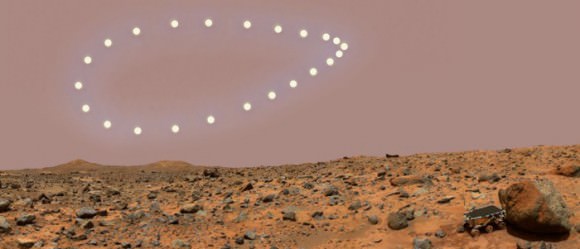
As far as the solar system missions going on we’ve already enjoyed the flyby of Comet Hartley 2 by the Deep impact/EPOXI spacecraft, and the NASA O/OREOS (“Organism/ORganic Exposure to Orbital Stresses,”) spacecraft was launched in November 2010, to study “the durability of life in space.” It is a nanosatellite (a cubesat), only 5.5 kilograms in mass, and we’ll certainly be hearing more about that spacecraft soon.
NASA NanoSail-D was also launched by the same rocket, and it has been ejected from the spacecraft but hasn’t yet unfurled its sails. We’ll post something as soon as any news on that emerges.
Here are more upcoming mission highlights as part of the YSS:
Stardust NExT encounters comet Tempel on February 14.
MESSENGER enters an orbit around the planet Mercury on March 18.
Dawn begins its approach to the asteroid Vesta in May, for a mission between 2011 and 2012. It will also visit the dwarf planet Ceres in 2015.
The Juno spacecraft will launch to Jupiter in August 2011. It will study the planet’s composition, gravity field, magnetic field, and polar magnetosphere.
GRAIL, or the NASA Gravity Recovery and Interior Laboratory (GRAIL) spacecraft will launch for a mapping mission to the Moon in September 2011.
Curiosity, or the Mars Science Lab will launch in November 2011. This is a big, car-sized rover that will look for potential habitable places, and more, on Mars. Curiosity is slated to land in August, 2012.
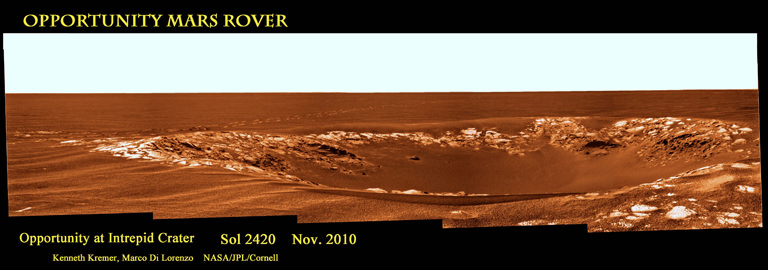
[/caption]
NASA recently celebrated the anniversary of the historic Apollo 12 lunar landing mission with another history making craft – the long lived Opportunity Mars rover. Opportunity traversed around and photographed ‘Intrepid’ crater on Mars in mid November 2010. The crater is informally named in honor of the ‘Intrepid’ lunar module which landed two humans on the surface of the moon on 19 November 1969, some forty one years ago.
Apollo 12 was only the second of NASA’s Apollo missions to place humans on the Earth’s moon. Apollo astronauts Pete Conrad and Gordon Bean precisely piloted their lunar landing spacecraft nicknamed ‘Intrepid’ to a safe touchdown in the ‘Ocean of Storms’, a mere 180 meters (600 feet) away from the Surveyor 3 robotic lunar probe which had already landed on the moon in April 1967. The unmanned Surveyor landers paved the way for NASA’s manned Apollo landers.
As Conrad and Bean walked on the moon and collected lunar rocks for science, the third member of the Apollo 12 crew, astronaut Dick Gordon, orbited alone in the ‘Yankee Clipper’ command module and collected valuable science data from overhead.
On the anniversary of the lunar landing, the rover science team decided to honor the Apollo 12 mission as Opportunity was driving east and chanced upon a field of small impact craters located in between vast Martian dune fields. Informal crater names are assigned by the team to craters spotted by Opportunity in the Meridiani Planum region based on the names of historic ships of exploration.

Rover science team member James Rice, of NASA’s Goddard Space Flight Center, Greenbelt, Md., suggested using names from Apollo 12 because of the coincidental timing according to NASA. “The Apollo missions were so inspiring when I was young, I remember all the dates. When we were approaching these craters, I realized we were getting close to the Nov. 19 anniversary for Apollo 12,” Rice said. He sent Bean and Gordon photographs that Opportunity took of the two craters named for the two Apollo 12 spaceships.
Bean wrote back the following message to the Mars Exploration Rover team: “I just talked with Dick Gordon about the wonderful honor you have bestowed upon our Apollo 12 spacecraft. Forty-one years ago today, we were approaching the moon in Yankee Clipper with Intrepid in tow. We were excited to have the opportunity to perform some important exploration of a place in the universe other than planet Earth where humans had not gone before. We were anxious to give it our best effort. You and your team have that same opportunity. Give it your best effort.”
On November 4, Opportunity drove by and imaged ‘Yankee Clipper’ crater. After driving several more days she reached ‘Intrepid’ on November 9. The rover then traversed around the crater rim and photographed the crater interior from different vantage points, collecting two panoramic views along the way.
The rover team assembled the initial tribute panoramic mosaic taken on Sol 2417 (Nov. 11) and which can be seen here in high resolution along with ‘Yankee Clipper’.
Opportunity soon departed Intrepid on Sol 2420 (Nov. 14) to resume her multi-year trek eastwards and took a series of crater images that day – from a very different direction – which we were inspired to assemble into a panoramic mosaic (in false color) in tribute to the Apollo 12 mission (see above).
Our mosaic tribute clearly shows the rover wheel tracks as Opportunity first approached Intrepid on Nov. 9 – which is fittingly reminiscent of the Apollo 12 astronauts walking on the moon 41 years ago as they explored a lunar crater. By comparison, the arrival mosaic from Sol 2417 shows distant Endeavour crater in the background.
Intrepid crater is about 16 meters in diameter, thus similar in size to ‘Eagle’ crater inside which Opportunity first landed on 24 January 2004 after a 250 million mile ‘hole in one shot’ from Earth. Eagle was named in honor of the Apollo 11 mission.
“Intrepid is fairly eroded with sand filling the interior and ejecta blocks planed off by the saltating sand”, said Matt Golembek, Mars Exploration Program Landing Site Scientist at the Jet Propulsion Laboratory (JPL), Pasadena, Calif. Asked about the age of Intrepid crater, Golembek told me; “Based on the erosional state it is at least several million years old, but less than around 20 million years old.”
Opportunity is blazing ahead towards a huge 22 km (14 mile) wide crater named ‘Endeavour’, which shows distinct signatures of clays and past wet environments based on orbital imagery thus making the crater a compelling science target.
“Intrepid is 1.5 km from Santa Maria crater and about 7.5 km from Endeavour.”
“We should be at Santa Maria crater next week, where we will spend the holidays and conjunction. Then it will be 6 km to Endeavour,” Golembek said.
The road ahead looks to be alot friendlier to the intrepid rover. “The terrain Opportunity is on is among the smoothest and easiest to traverse since Eagle and Endurance. Should be smooth sailing to Endeavour, averaging about 100 meters per drive sol. We should easily beat MSL to the phyllosilicates,” Golembek explained.
Phyllosilicates are clay minerals that form under wet, warm, non-acidic conditions. They have never before been studied on the Martian surface.
MSL is the Mars Science Lab, NASA’s next Mars lander mission and which is scheduled to blast off towards the end of 2011. Golembek leads the landing site selection team.
The amazing Opportunity rover has spent nearly seven years roving the Martian surface, conducting a crater tour during her very unexpectedly long journey at ‘Meridiani Planum’ on Mars which now exceeds 26 km (16 miles). The rovers were designed with a prime mission “warranty” of just 90 Martian days – or sols – and have vastly exceeded their creators expectations.
“What a ride. This still does not seem real,” Rob Manning told me. Manning headed the Entry, Descent and Landing team at JPL for both the Spirit and Opportunity rovers. “That would be fantastic if Opportunity could get to the phyllosilicates before MSL launches.”
Stay tuned.
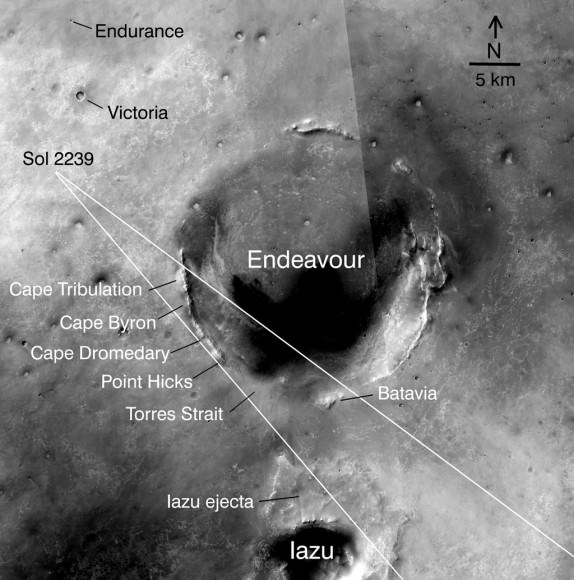
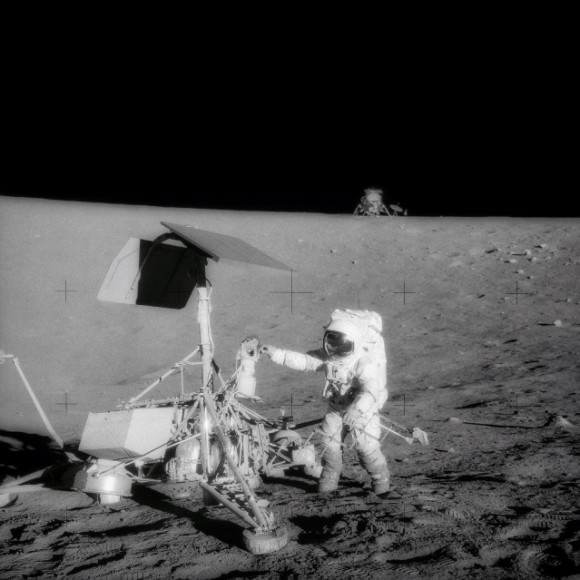
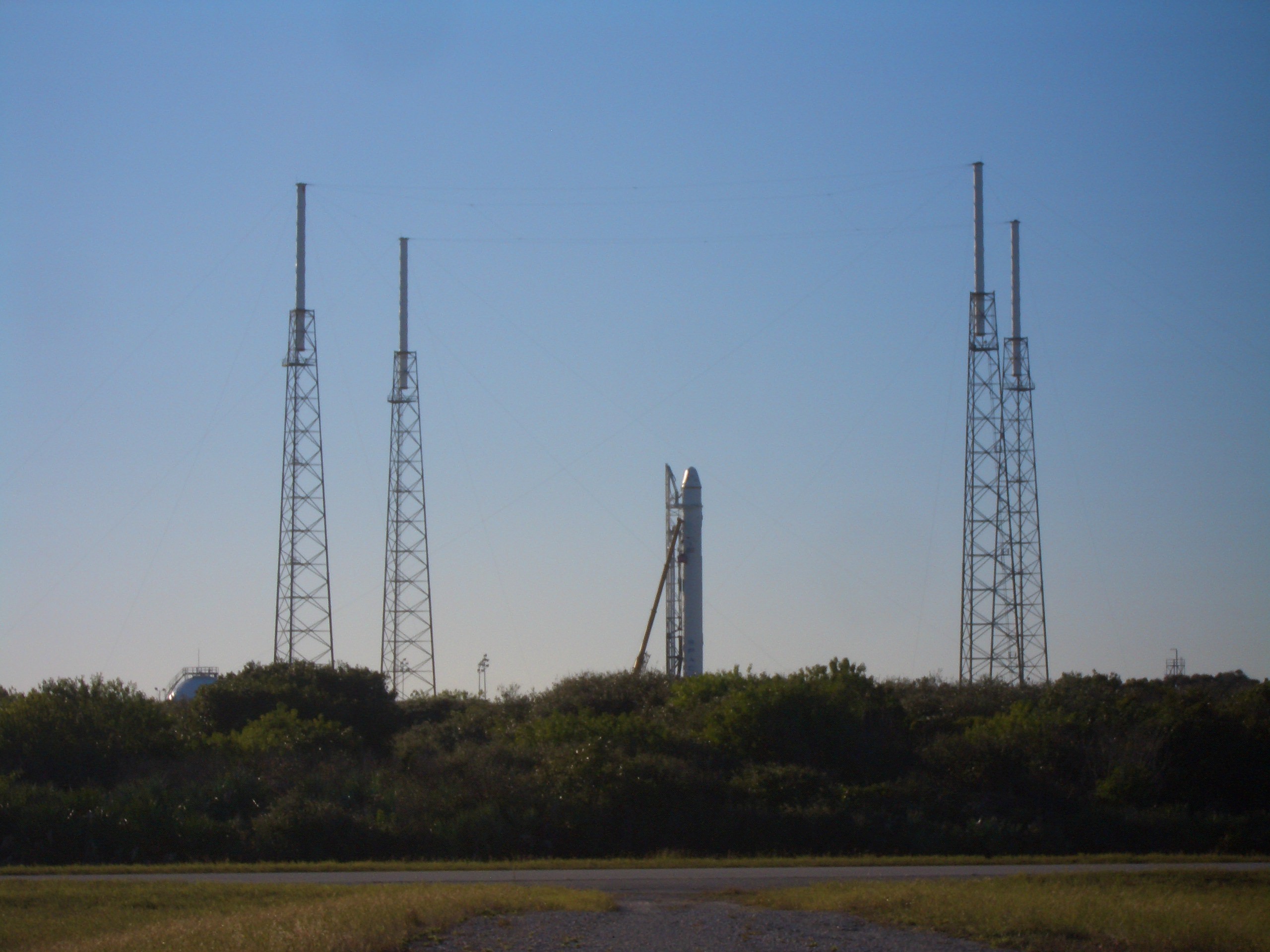
[/caption]
CAPE CANAVERAL –Engineers with the commercial space company SpaceX have analyzed two small cracks in the rear segment of the second stage engine nozzle. These cracks are located near the end of the nozzle extension where there is very little stress and so it is thought that they in themselves would not cause a flight failure. SpaceX decided that they did warrant further investigation to make sure that these cracks are not symptoms of a far larger problem.
SpaceX must have liked what they saw because the company has decided to go ahead with the launch, now scheduled for Wednesday. The launch window will open at 9 a.m. EDT and will close at 12:22 p.m. EDT.
The bell shaped Merlin Vacuum nozzle is made out of niobium sheet alloy, and is approximately 9 feet tall and 8 feet at the base. This nozzle thins out to approximately twice the thickness of a soda can near the end. Although it is composed of a refractory alloy metal and has a melting temperature high enough to boil steel, this component is, in geometric terms, the simplest component of the engine.
The niobium nozzle extension works to increase the overall efficiency of the Merlin engine while on-orbit. For this first flight of the Dragon, this efficiency is not required, but the component was placed on the rocket’s second stage by default.
SpaceX is launching the first of its Dragon spacecraft on the first demonstration flight under the $1.6 billion Commercial Orbital Transportation Services (COTS) contract that the space firm has with NASA. Under this contract SpaceX is required to fly three demonstration flights before conducting 12 supply missions to the International Space Station (ISS).
